So you’ve finally decided to go on that long-coveted India vacation but can’t decide between North and South India? Here’s the lowdown on what each region has to offer.
India is incredibly diverse, with both North and South India offering wondrous cultural and culinary experiences and natural beauty. It’s got the lofty Himalayas in the north and the vast Indian Ocean to the south. Rajasthan’s royalty versus the serenity of Kerala’s backwaters. Butter chicken versus idlis and dosas. Each experience is equally delightful, colorful, and deeply engaging.
The number of things to do and places to visit in India are limitless. So how do you choose between North and South India? Our India travel advice will help you find the answers. Here’s the lowdown on the unique culture, cuisine and natural attractions in North and South India.
Tourist Attractions in India: Culture and Heritage
If you thought North India was only about the Golden Triangle of Delhi, Agra and Jaipur, think again! It is a veritable goldmine of culture and heritage, drawing from both Hindu and Mughal influences. This is the India of your dreams — of mysterious forts, mustachioed maharajas, painted elephants, and tall glasses of lassi, the preferred yogurt-based refresher.
Start with Delhi – India’s capital, which is known for its rich cultural and gastronomic experiences.
Start with Delhi – India’s capital, which is known for its rich cultural and gastronomic experiences. Zip down the Yamuna Expressway to Agra and go on a Taj Mahal tour. This picture perfect paean of love is the final resting place of Mumtaz Mahal, wife of Mughal Emperor Shah Jahan, who built it in her memory.
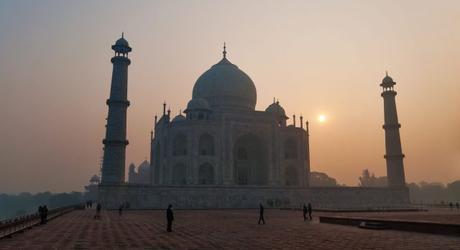 The Taj Mahal in Agra
The Taj Mahal in Agra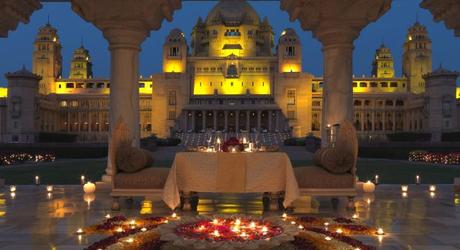 Palace stays in Jodhpur
Palace stays in Jodhpur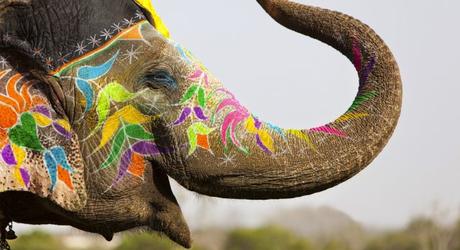 Elephants in Jaipur
Elephants in Jaipur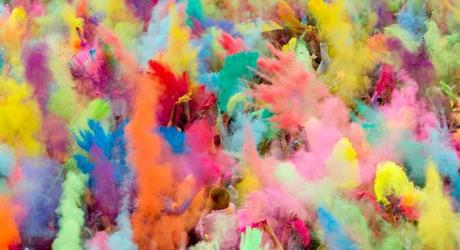 Holi Festival
Holi Festival 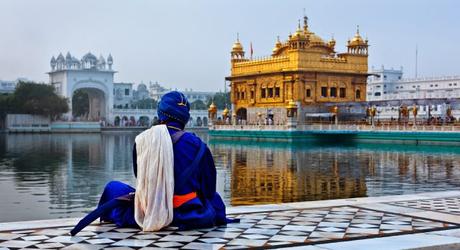 Golden Temple of Amritsar
Golden Temple of Amritsar
Then there’s vibrant Rajasthan, the land of maharajas, where folklore, romance and heroism resonates across formidable forts. Visit the pink and blue cities of Jaipur and Jodhpur. Veer off the beaten path into rural Rajasthan, where you can feast on delightful Indian cuisine and rest your head in regal palaces. Head to Amritsar in Punjab and explore the Golden Temple, a religious epicenter and an architectural marvel. Embrace spirituality on the ghats (river bank) of the revered River Ganges in Varanasi. If festive revelry is what you’re looking for, get painted in a riot of colors at Vrindavan during Holi, the festival of colors. And architecture buffs, don’t miss the sensual carvings of Khajuraho, where passion is not a sin.
South India is as alluring as the North, and dazzles with its gold-laden idols within extravagant temples, cultural monuments, and Ayurvedic treatments. Yet, a distinctive identity, languages, and local cultures set South India apart from the North. Here, men traditionally wear the sarong-like lungi while women look resplendent in gorgeous silk saris and flowers in their hair.
 Beaches of Goa
Beaches of Goa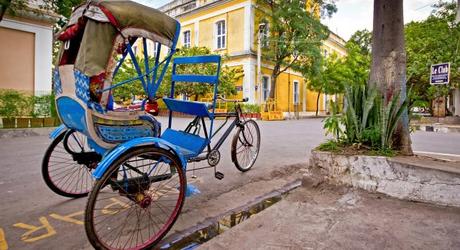 Colonial architecture of Pondicherry
Colonial architecture of Pondicherry Hampi: an architectural delight
Hampi: an architectural delight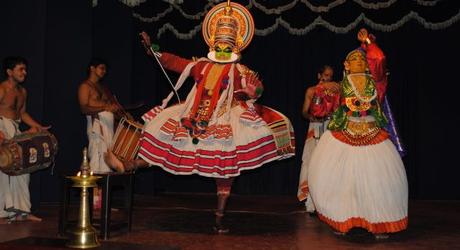 Kathakali Dance Performance
Kathakali Dance Performance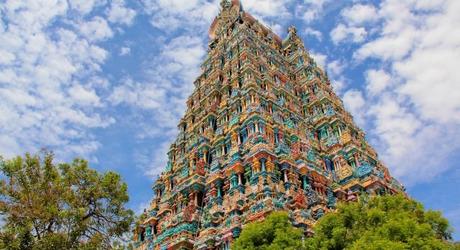 Madurai: Meenakshi Temple
Madurai: Meenakshi Temple
The rock-cut temples of Hampi, sculpture and art of Belur are all centuries-old masterpieces.
Mounds of flowers, long queues of Hindu devotees, and grand architecture greet visitors in Chennai and in the temple town of Madurai. The rock-cut temples of Hampi, sculpture and art of Belur, and the region’s lesser-known cave temples are all centuries-old masterpieces.
In Kochi on the west coast, historic churches stand beside colonial buildings that have been converted into boutique hotels. Tour Goa’s old churches and peek into its Portuguese past. We’ll also show you the best beaches in Goa. Along the eastern coastline on the other hand, lies the ex-French enclave of Puducherry, where the township of Auroville was set up to promote peace and human unity.
At night, attend an operatic Kathakali performance, best remembered for the dancers’ elaborate costumes and makeup. Enjoy Carnatic music and Kalaripayattu, one of the oldest fighting forms of Indian martial arts on your private South India tours. Your India vacation is incomplete without a visit to Kanyakumari, the southernmost tip of India, where the sun sets and the moon rises above the same sea.
You can be anywhere, North or South, for Diwali, the festival of lights!
India travel tips: Nature and wildlife
North India, with cold winters, hot summers and moderate monsoons, is a mecca for mountain lovers and adventure enthusiasts. From quiet, picturesque hill stations nestled in the Himalayas to national parks teeming with animals; from delightful glamping experiences amid the lofty mountains of Ladakh to trekking in the Himalayas and river rafting in Rishikesh, you can do it all in North India.
Follow the trail of the Royal Bengal Tiger at Ranthambore National Park, one of India’s most famous tiger reserves. If you never believed in a fairytale wonderland, visit the Valley of Flowers in Uttarakhand — you’re sure to have a change of heart!
 Royal Bengal Tiger, Ranthambore
Royal Bengal Tiger, Ranthambore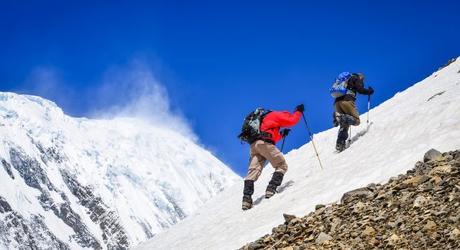 Trekking in the Himalayas
Trekking in the Himalayas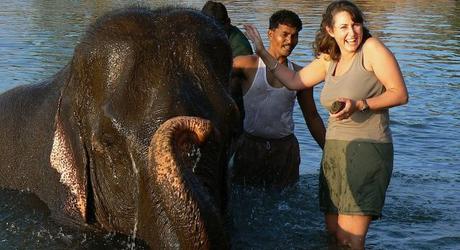 Wildlife encounters in North India
Wildlife encounters in North India Glamping in Leh
Glamping in Leh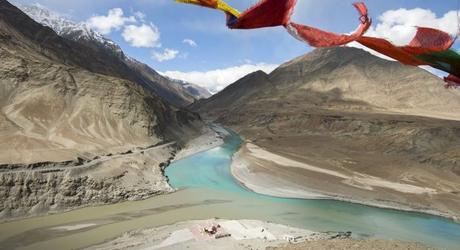 Ladakh
Ladakh
South India is home to fantastic wildlife, great beaches and serene backwaters.
On your South India tour, the first thing that will strike you is the climate, which is more tropical than the North, with its humidity and warmth. South India is home to fantastic wildlife, great beaches and serene backwaters. Glide through Kerala’s backwaters and watch an unhurried pace of life unfold in the villages of South India. A luxurious Alleppey houseboat tour is a must in the palm-fringed canals of God’s Own Country.
 Pristine beach in the Andamans
Pristine beach in the Andamans Houseboat tours in Kerala
Houseboat tours in Kerala At the Periyar dam of South India
At the Periyar dam of South India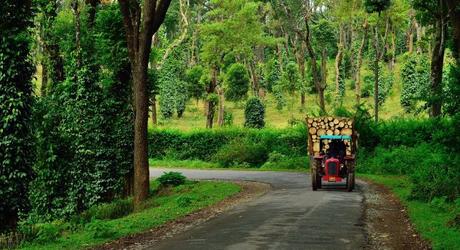 Evergreen hill country of Coorg
Evergreen hill country of Coorg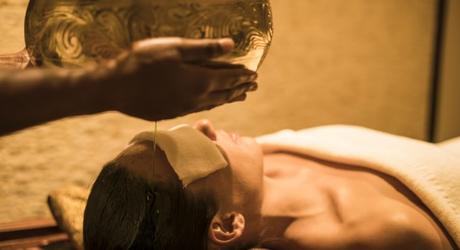 Ayurveda treatments in South India
Ayurveda treatments in South India
Follow this up with Ayurveda massages and treatments along with yoga and meditation at resorts on Kerala’s coast, or at hill stations set among spice and tea plantations. Don’t miss a trip to Nagarhole Wildlife Park, a haven for elephants and tigers. Scuba dive in Havelock in the Andamans or enjoy bamboo rafting in the Periyar.
Best Indian dishes: Butter chicken or dosa?
Are you a fan of the fragrant ghee-laden (clarified butter) sweetmeats and rich, nutty gravies typical of North Indian cuisine or do you prefer the tropical flavors of coconut, lime and chilies, spiced up with peppercorns, found in South India? Either way, we’ll make sure you sample some of best Indian dishes on your India visit.
North Indian cuisine is known for its creamy, moderately spicy gravies paired with a variety of breads
 A typical North Indian meal
A typical North Indian meal
North Indian cuisine is known for its creamy, moderately spicy gravies paired with a variety of breads such as stuffed parathas (flaky bread with vegetarian and non-vegetarian fillings), naans and kulchas (bread made of leavened dough) and tandoori rotis (bread cooked in an clay oven). Dried fruits and nuts and dairy products like milk, cream, clarified butter and yogurt are used liberally in both sweets and savouries. Rice is an occasional treat and is usually made into pulaos (pilafs) or biryanis.
South Indian food food is primarily centered on rice, which grows throughout the region. The cereal is eaten boiled, steamed, and fashioned into many a form such as idlis, savory rice cakes, and dosas, savory pancakes. The curries are often laden with chilies, tamarind, curry leaves, and spices, especially peppercorns, with delicate coconut milk offsetting the heat. Coconut is used in all its forms — desiccated, grated, chopped, milked — in savories as well as sweets.
A typical South Indian meal is served on a banana leaf and taken in many courses.
 A typical South India meal
A typical South India meal
A typical South Indian meal is served on a banana leaf and taken in many courses. Coastal Karnataka is a seafood lover’s paradise, while Pondicherry’s cuisine has distinct French influences. Meat lovers would do well to check out Coorg’s famous Pandi Curry (pork curry) and Kerala’s beef roast. Indian food, whether northern or southern, is sure to tickle your tastebuds and leave you asking for more.
So now back to the big question — which is best for your India vacation — North or South? It’s all about your personal preferences, really, and the experiences that appeal to you. And let’s accept it. If you start your India tour with the knowledge that no matter what its length, it will never be long enough, it might just be easier to decide. Believe us, you’re likely to come back for more!
Plan my trip
